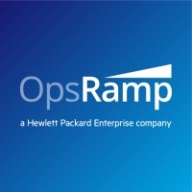

Splunk Observability Cloud and OpsRamp compete in the application performance monitoring category. Splunk Observability Cloud appears to have the upper hand with its comprehensive data integration and real-time problem-solving abilities, though OpsRamp excels in AIOps features and cost-effectiveness.
Features: Splunk Observability Cloud is strong in end-to-end visibility, advanced dashboards, and comprehensive data integration. OpsRamp stands out with strong alerting tools, seamless ITSM integration, and its multi-tenant architecture.
Room for Improvement: Splunk Observability Cloud could enhance its stability, integration capabilities, and dashboard intuitiveness. OpsRamp could improve its ITSM features, network capabilities, and process automation.
Ease of Deployment and Customer Service: Splunk Observability Cloud supports various cloud environments but has room for improvement in technical support responsiveness. OpsRamp focuses on public and hybrid cloud setups and has clear and responsive customer support.
Pricing and ROI: Splunk Observability Cloud's data ingestion-based pricing model is often seen as expensive, but it delivers valuable insights for users, leading to productivity gains. OpsRamp offers a more cost-effective pricing structure, perceived as providing good value and delivering solid ROI.
It is important to stick with available features and provide customers with clear, precise details about what can and cannot be done to avoid anomalies.
I find the licensing model convenient and clear enough, and I have seen a return on investment with OpsRamp.
Using Splunk has saved my organization about 30% of our budget compared to using multiple different monitoring products.
Anyone working in front-end management should recognize the market price to see the true value of end-user monitoring.
I have definitely seen a return on investment with Splunk Observability Cloud, particularly through how fast it has grown and how comfortable other teams are in relying on its outputs for monitoring and observability.
Having a dedicated firefighter team for each MSP would be beneficial.
On a scale of 1 to 10, the customer service and technical support deserve a 10.
They have consistently helped us resolve any issues we've encountered.
They often require multiple questions, with five or six emails to get a response.
We've used the solution across more than 250 people, including engineers.
As we are a growing company transitioning all our applications to the cloud, and with the increasing number of cloud-native applications, Splunk Observability Cloud will help us achieve digital resiliency and reduce our mean time to resolution.
I would rate its scalability a nine out of ten.
I would rate its stability a nine out of ten.
We rarely have problems accessing the dashboard or the page.
Unlike NetScout or regular agents for APM, RUM has many problems during the POC phase because customer environments vary widely.
Technical support should be improved.
The out-of-the-box customizable dashboards in Splunk Observability Cloud are very effective in showcasing IT performance to business leaders.
The next release of Splunk Observability Cloud should include a feature that makes it so that when looking at charts and dashboards, and also looking at one environment regardless of the product feature that you're in, APM, infrastructure, RUM, the environment that is chosen in the first location when you sign into Splunk Observability Cloud needs to stay persistent all the way through.
There is room for improvement in the alerting system, which is complicated and has less documentation available.
it does not strike me as expensive, and the licensing model is clear enough.
Splunk is a bit expensive since it charges based on the indexing rate of data.
It is expensive, especially when there are other vendors that offer something similar for much cheaper.
It appears to be expensive compared to competitors.
I have utilized OpsRamp's capability for predictive analytics, and it has been important in fostering collaboration between my IT and development teams under DevOps methodologies, where applicable.
Splunk provides advanced notifications of roadblocks in the application, which helps us to improve and avoid impacts during high-volume days.
For troubleshooting, we can detect problems in seconds, which is particularly helpful for digital teams.
It offers unified visibility for logs, metrics, and traces.
| Product | Market Share (%) |
|---|---|
| Splunk Observability Cloud | 2.0% |
| OpsRamp | 2.5% |
| Other | 95.5% |


| Company Size | Count |
|---|---|
| Small Business | 1 |
| Midsize Enterprise | 3 |
| Large Enterprise | 8 |
| Company Size | Count |
|---|---|
| Small Business | 20 |
| Midsize Enterprise | 10 |
| Large Enterprise | 43 |
OpsRamp is a leading cloud-based digital IT operations management platform. The solution allows your organization to leverage hybrid observability, process automation, and machine learning to modernize IT operations. OpsRamp can handle the speed, scope, and scale of modern IT and can help you drive productivity and business value. In addition, it can help your business manage, monitor, and consolidate your point tools and applications.
OpsRamp Features
OpsRamp has many valuable key features. Some of the most useful ones include:
OpsRamp Benefits
There are many benefits to implementing OpsRamp. Some of the biggest advantages the solution offers include:
Splunk Observability Cloud offers sophisticated log searching, data integration, and customizable dashboards. With rapid deployment and ease of use, this cloud service enhances monitoring capabilities across IT infrastructures for comprehensive end-to-end visibility.
Focused on enhancing performance management and security, Splunk Observability Cloud supports environments through its data visualization and analysis tools. Users appreciate its robust application performance monitoring and troubleshooting insights. However, improvements in integrations, interface customization, scalability, and automation are needed. Users find value in its capabilities for infrastructure and network monitoring, as well as log analytics, albeit cost considerations and better documentation are desired. Enhancements in real-time monitoring and network protection are also noted as areas for development.
What are the key features?In industries, Splunk Observability Cloud is implemented for security management by analyzing logs from detection systems, offering real-time alerts and troubleshooting for cloud-native applications. It is leveraged for machine data analysis, improving infrastructure visibility and supporting network and application performance management efforts.
We monitor all IT Infrastructure Monitoring reviews to prevent fraudulent reviews and keep review quality high. We do not post reviews by company employees or direct competitors. We validate each review for authenticity via cross-reference with LinkedIn, and personal follow-up with the reviewer when necessary.